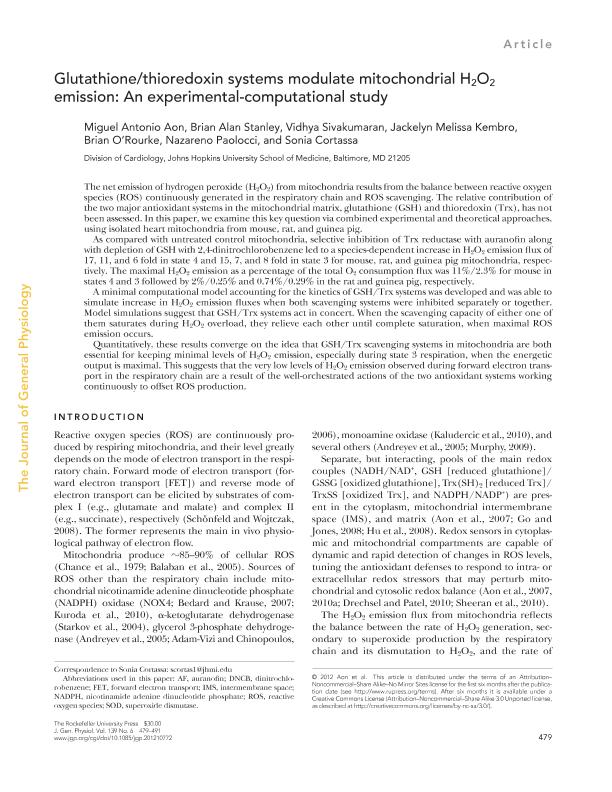Mostrar el registro sencillo del ítem
dc.contributor.author
Aon, Miguel Antonio
dc.contributor.author
Stanley, Brian Alan
dc.contributor.author
Sivakumaran, Vidhya
dc.contributor.author
Kembro, Jackelyn Melissa

dc.contributor.author
O'Rourke, Brian
dc.contributor.author
Paolocci, Nazareno
dc.contributor.author
Cortassa, Sonia
dc.date.available
2018-04-19T14:13:58Z
dc.date.issued
2012-06
dc.identifier.citation
Aon, Miguel Antonio; Stanley, Brian Alan; Sivakumaran, Vidhya; Kembro, Jackelyn Melissa; O'Rourke, Brian; et al.; Glutathione/thioredoxin systems modulate mitochondrial H2O2 emission: An experimental-computational study; Rockefeller University Press; Journal Of General Physiology; 139; 6; 6-2012; 479-491
dc.identifier.issn
0022-1295
dc.identifier.uri
http://hdl.handle.net/11336/42623
dc.description.abstract
The net emission of hydrogen peroxide (H2O2) from mitochondria results from the balance between reactive oxygen species (ROS) continuously generated in the respiratory chain and ROS scavenging. The relative contribution of the two major antioxidant systems in the mitochondrial matrix, glutathione (GSH) and thioredoxin (Trx), has not been assessed. In this paper, we examine this key question via combined experimental and theoretical approaches, using isolated heart mitochondria from mouse, rat, and guinea pig. As compared with untreated control mitochondria, selective inhibition of Trx reductase with auranofin along with depletion of GSH with 2,4-dinitrochlorobenzene led to a species-dependent increase in H2O2 emission flux of 17, 11, and 6 fold in state 4 and 15, 7, and 8 fold in state 3 for mouse, rat, and guinea pig mitochondria, respectively. The maximal H2O2 emission as a percentage of the total O2 consumption flux was 11%/2.3% for mouse in states 4 and 3 followed by 2%/0.25% and 0.74%/0.29% in the rat and guinea pig, respectively. A minimal computational model accounting for the kinetics of GSH/Trx systems was developed and was able to simulate increase in H2O2 emission fluxes when both scavenging systems were inhibited separately or together. Model simulations suggest that GSH/Trx systems act in concert. When the scavenging capacity of either one of them saturates during H2O2 overload, they relieve each other until complete saturation, when maximal ROS emission occurs. Quantitatively, these results converge on the idea that GSH/Trx scavenging systems in mitochondria are both essential for keeping minimal levels of H2O2 emission, especially during state 3 respiration, when the energetic output is maximal. This suggests that the very low levels of H2O2 emission observed during forward electron transport in the respiratory chain are a result of the well-orchestrated actions of the two antioxidant systems working continuously to offset ROS production.
dc.format
application/pdf
dc.language.iso
eng
dc.publisher
Rockefeller University Press

dc.rights
info:eu-repo/semantics/openAccess
dc.rights.uri
https://creativecommons.org/licenses/by-nc-sa/2.5/ar/
dc.subject
Glutathione System
dc.subject
Thioredoxin System
dc.subject
Ros
dc.subject.classification
Otras Ciencias Biológicas

dc.subject.classification
Ciencias Biológicas

dc.subject.classification
CIENCIAS NATURALES Y EXACTAS

dc.title
Glutathione/thioredoxin systems modulate mitochondrial H2O2 emission: An experimental-computational study
dc.type
info:eu-repo/semantics/article
dc.type
info:ar-repo/semantics/artículo
dc.type
info:eu-repo/semantics/publishedVersion
dc.date.updated
2018-04-10T14:04:41Z
dc.identifier.eissn
1540-7748
dc.journal.volume
139
dc.journal.number
6
dc.journal.pagination
479-491
dc.journal.pais
Estados Unidos

dc.journal.ciudad
New York
dc.description.fil
Fil: Aon, Miguel Antonio. University Johns Hopkins; Estados Unidos
dc.description.fil
Fil: Stanley, Brian Alan. University Johns Hopkins; Estados Unidos
dc.description.fil
Fil: Sivakumaran, Vidhya. University Johns Hopkins; Estados Unidos
dc.description.fil
Fil: Kembro, Jackelyn Melissa. University Johns Hopkins; Estados Unidos. Consejo Nacional de Investigaciones Científicas y Técnicas. Centro Científico Tecnológico Conicet - Córdoba. Instituto de Investigaciones Biológicas y Tecnológicas. Universidad Nacional de Córdoba. Facultad de Ciencias Exactas, Físicas y Naturales. Instituto de Investigaciones Biológicas y Tecnológicas; Argentina
dc.description.fil
Fil: O'Rourke, Brian. University Johns Hopkins; Estados Unidos
dc.description.fil
Fil: Paolocci, Nazareno. University Johns Hopkins; Estados Unidos
dc.description.fil
Fil: Cortassa, Sonia. University Johns Hopkins; Estados Unidos
dc.journal.title
Journal Of General Physiology

dc.relation.alternativeid
info:eu-repo/semantics/altIdentifier/url/http://jgp.rupress.org/content/139/6/479
dc.relation.alternativeid
info:eu-repo/semantics/altIdentifier/doi/http://dx.doi.org/10.1085/jgp.201210772
Archivos asociados
